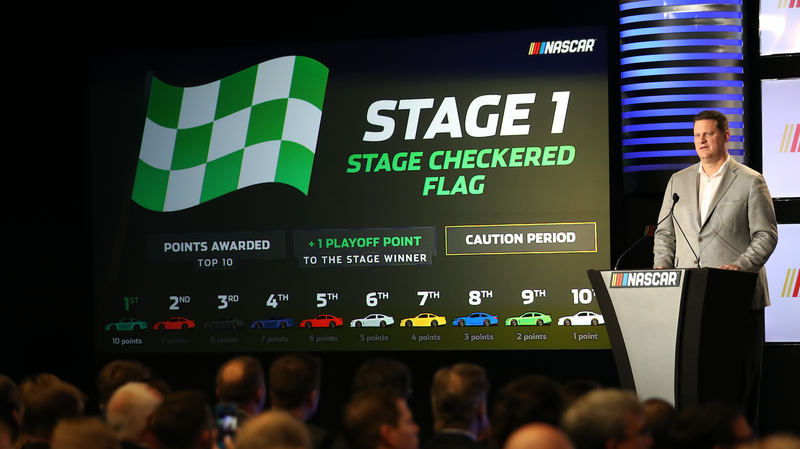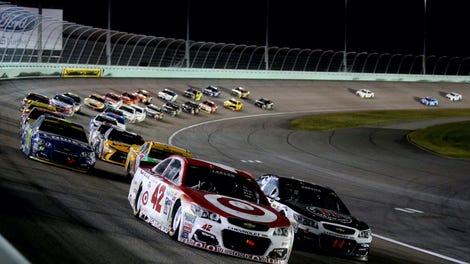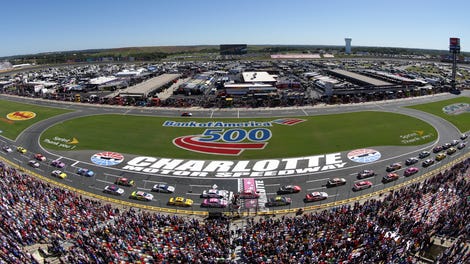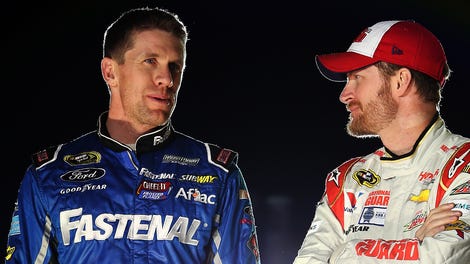
Perhaps one of the most widespread critiques about NASCAR is that “something has to change.” The races are “too long” or “too boring,” and all they do is “make left turns.” But if you look back on the last few years, too much change has occurred—and it’s been more of a plague than an improvement.
The most recent set of changes to the sport came on Monday evening when NASCAR executives and drivers announced a new racing format for all three of NASCAR’s national series to be implemented at each race throughout the 2017 season, effective at the drop of the first green flag in February.
But main problem here isn’t any of the formats, past or present—even if the newest one is more of a calculus equation than an outline for how to conduct a sporting event. The biggest problem is that NASCAR can’t settle on a format, no matter what that format may be.
Let’s break down where the approach goes wrong, from the smaller stuff to the bigger picture.
The New Format Is Way Too Complicated
There is no basic way to explain the new format, but here goes nothing: each race in all three of NASCAR’s top national series—the Monster Energy NASCAR Cup Series, Xfinity Series and Camping World Truck Series—will be divided into three segments. The sanctioning body created a new flag with green and white checkers to end the first two segments, or “stages.” That’s likely to make it feel more “official” and less like a predetermined caution flag.
There will be a break that’s expected to last about 10 minutes at the end of each stage, and the finishing order at the end of stages matters: the top-10 drivers in the running order will get points for their “stage” finish. There are also extra playoff points tossed toward stage and race winners, to be carried over once the postseason begins. Under the old system, playoff drivers only received bonus points for wins at the end of the regular season once the points reset to begin the championship races.
The only race those playoff points won’t count toward is the season finale for the four drivers remaining in the title hunt, which is one of the few things NASCAR kept consistent from the previous few years.
There will also be a regular-season champion, decided by the driver who scores the most points during the “regular” season in NASCAR. The number of regular and playoff races varies in each series, but the regular-season winner will also get a hefty 15 bonus points toward the championship races while the other top-10 drivers in the points also receive extra playoff points.
Drivers will also receive points for their finishes in the duel races at Daytona International Speedway under the new series format, though these races only exist to decide the starting lineup for the Daytona 500. That’s on top of all the changes made in 2014, which will be outlined below.
Basically, it’s all too much.
If you’re confused about the newest edition of NASCAR, this video may help—but probably not as much as you need it to.
The most basic problem here is that if you tried to explain the new format to someone who hadn’t watched NASCAR before—forget about the rules on the race track, on pit road, in the garage and everywhere else, which, like many sports, are overwhelming enough on their own—they’d stare at you, mouth agape, wondering why anyone would try to understand this.
Confusion is not the key to success, in sports or most other aspects of life. Take a look back at NASCAR’s disastrous All-Star Race format from 2016, during which neither the fans, the drivers nor anyone else really knew what was going on or what to do next. That isn’t how things should be.
NASCAR Is Making Changes Almost Compulsively Now
Overall, it seems like a lot of people like this new format. NASCAR called in drivers and other bigwigs to help them decide on the final product announced on Monday, and the reception seemed positive. That’s all well and good, and hopefully it helps NASCAR to accomplish its goals. (If not, we’ll all probably have to sit through another format change come 2018.)
But, again, the problem here isn’t whether or not the format will produce good racing. These are some of the best stock-car drivers in the world. Changes to a format shouldn’t be how the sanctioning body produces “good racing.”
That doesn’t stop NASCAR from continuing to make changes. To make this easier, let’s just do a bullet-point list of the changes NASCAR has made over the past several years. It’ll probably still get overwhelming that way, to be honest.
2014:
- NASCAR announces a new Chase for the Championship postseason format that puts more emphasis on winning races during the season. The format only goes into effect in the top Monster Energy NASCAR Cup Series.
- The Chase field expands from 10 drivers to 16, with four drivers knocked out at the end of each “round” during the 10-race Chase. Before knockouts, the driver who accumulated the most points during the Chase races won the title.
- A victory during the regular-season races likely guarantees a Chase berth, with Chase drivers decided by those with wins. If 16 do not win during the regular season, the rest of the spots will be filled by the drivers highest in points.
- The knockout rounds in the Chase are known as the “Challenger Round,” the “Contender Round,” the “Eliminator Round” and the “NASCAR Sprint Cup Championship” race under the series’ former title sponsor.
- The highest finisher in the season finale at Homestead-Miami Speedway will win the Cup Series championship.
2015:
- The series made no major changes to the system in 2015, with NASCAR Chairman and CEO Brian France saying that the sanctioning body wanted to “make sure that simplicity is right there.”
2016:
- NASCAR spreads its knockout-style Chase format to the Xfinity Series and Camping World Truck Series, which was the first time either series featured a championship Chase.
- The Xfinity Series and Camping World Truck Series Chase will both consist of seven races and three rounds. The first two rounds will be elimination, and, like the Cup Series, the final round will consist of four drivers. The highest finisher at Homestead-Miami Speedway will win the championship.
- The Chase rounds lose their names. They are now known as the Round of 16, Round of 12, Round of 8 and the Championship 4.
- The three series will not start their Chases or end their elimination rounds on the same weekend, except for the final elimination round and the title race.
- The Xfinity Series’ four “Dash 4 Cash” races will each have heat races and a main event.
- The NASCAR Camping World Truck Series will utilize a caution clock, which will count down from 20 minutes during green-flag runs and be reset every time there is a caution on track. Whenever the clock hits zero, officials will call a caution.
- NASCAR replaces its green-white-checkered system of ending a race with an “overtime line.” If a late-race caution caused the race to go over its scheduled distance under the green-white-checkered system, a green-flag lap an a white-flag lap would be run. There would be three attempts at ending the race under green. Before the third attempt, cautions would only end the race if they came on the white-flag lap. Under the overtime line, competitors only have to make it to a line that differs on every race track during the first lap of a green-white-checkered format. After passing the overtime line, the next flag ends the race.
- With NASCAR’s introduction of a charter system, the number of cars racing in the series’ top division went from 43 to 40.
2017:
- Races in all three top series will be split into three segments, with the first two ending in a green and white checkered flag.
- The sanctioning body will no longer use the term “Chase” to describe its championship races. The races will now be known as the “playoffs.” The Chase was the name of the postseason since its inception in 2004.
- The top-10 drivers at the end of each stage will receive bonus “playoff” points.
- The top drivers in regular-season points will receive bonus points toward the playoffs.
- Points will be awarded for the two duel races at Daytona International Speedway, which are used to decide the running order for the Daytona 500.
- Several years after simplifying the points system to each race winner receiving 40 points—for finishing first out of 40 drivers—plus bonus, and each place below it receiving one less point, NASCAR changes the points system to award 40 points for the winner, second place to receive 35 points and the points to decrease by one from there. Positions 36 through 40 will each receive one point.
- The four drivers who compete for the title at Homestead-Miami Speedway will start with the same number of points, despite the new bonus system. The highest finisher wins the championship.
- Drivers will no longer receive bonus points for leading a lap or leading the most laps in a race.
- Teams will no longer be able to replace body panels during a race. If a driver goes to the garage after a wreck, he or she is likely done for the day.
- The NASCAR Camping World Truck Series will no longer have a caution clock. It lasted one season.
That’s a lot—a ridiculous amount, actually—of changes. Changing things this quickly is not only confusing for the current fanbase, it makes the sport almost inaccessible for casual fans. It just isn’t the way to go.
Just More Bandaids
When NASCAR announced its “win and you’re in” system in 2014, it essentially made the entire regular season irrelevant. It spread that system to the lower Xfinity Series and Camping World Truck Series in 2016, making all of NASCAR’s top series feature a convoluted title-deciding system from that point forward.
The problem was that system didn’t necessarily award consistency. The drivers who really had a shot at the title would almost always win at least one of the races counted as the “regular season” in NASCAR, and that automatically qualified them for a Chase berth so long as there weren’t more than 16 winners during that time and the drivers met the minimum requirements for competing in the postseason.
Those minimum requirements were—and still are, probably, since nothing was announced about playoff eligibility in Monday’s press conference—essentially, being in the top 30 in the points standings and attempting all of the regular-season races. The problem is, those bare-minimum requirements are usually only difficult to achieve if you get hurt or you’re a major underdog race winner.
The attempt requirement can be rendered irrelevant with a medical waiver, as we saw with Kyle Busch back in 2015: after breaking his foot and leg in the first Xfinity Series race of the year at Daytona International Speedway, Busch missed the season-opening Daytona 500 and 10 other races before coming back to score five wins, make it into the top 30 in points and go on to win the championship.
We’ve also seen drivers who were lackluster during the season win the title due to the format, or drivers who dominated the season meet the sad fate of a wreck in a late championship round.
Just check out last year: Jimmie Johnson won his seventh Cup Series title after he didn’t really make a statement during the season, while now-retired Carl Edwards lost out on the title after a dominating season due to a wreck in the season finale. William Byron, who won nearly a third of the Camping World Truck Series races in 2016, didn’t make the final four in the championship due to a blown engine in the penultimate race of the season.
The new format changes are a big bandaid on top of the mistake that allowed those drivers and others to either capitalize or miss out, and even Cup Series driver Denny Hamlin said “old-school fans actually should love this” new format because the sport is crowning a champion who performed in every race.
But in the old days, the champion was the driver who scored the most points. It was simple. This isn’t simple.
NASCAR Is A Game Now, Or At Least Feels Like It
Perhaps one of the most memorable marketing approaches that NASCAR took in recent memory was the “NASCAR, everything else is just a game” commercial series. It was intense. It highlighted the intensity of racing. It gave you all of the reasons you’d want to watch this non-game like sport.
But NASCAR is a game now, or it feels like one. It’s all about scoring the points at the end of each segment—points that aren’t even close to being as simple as touchdowns or two-point basketball shots—and making the playoffs.
Just look at the language. NASCAR added an “overtime” line at the beginning of the 2016 season, getting rid of green-white-checkered finishes and making it much easier to end the race under caution than it was under the old system. Nobody wins in that case, but it sounds like what the ball sports do, right?
Of course, these newest changes have potential. Everything has potential. On top of that, the knockout format in the now-called “playoffs” sounded miserable when it was introduced, and it wound up being entertaining—not necessarily being a good way to decide a champion, but entertaining.
NASCAR didn’t want to liken itself to playing a game several years ago, and perhaps it wouldn’t admit to wanting to do so these days. But, if anything, the constant format changes are playing with everyone’s head—especially the latest incarnation of them.






